Houses and
Grandstands: Henry Norrisí Architects
Last
updated: February 2009
KINNAIRD PARK ESTATE
COMPANY: WILLIAM JOSEPH AND LLEWELLYN HARRINGTON
I said at the
beginning of this file that Iím fairly sure that William Gilbert Allen
knew the
Harrington family. Here is why I think
that: on the day of the 1891 Census, William Harringtonís father, also
called
William, was the licensee at the Halfway House, 1 Caroline Place
Fulham, on the
corner with Lillie Road; meanwhile the Allen family were living at 3
The Parade
Lillie Road. The Halfway House would
have been their local pub but just as importantly, the children of both
families
will have gone to the same school; so William Gilbertís younger
siblings would
have known the elder Harrington children.
William Gilbert Allen (born 1869) had just started his own
building
business in 1891; KPECís William Harrington was 19 and working for his
father
in the pub, Llewellyn was 7 and still at school.
Working for his father
in a pub was not the obvious way into a career designing houses. How William Harrington moved from one to the
other
is not obvious to me: I donít know when he made the change of career. Nor do I know where he learned his
architecture trade. I do know that in
1894 he married Emily Ridsdill, who had been born in Croydon; and that
by 1898
they had moved to Bromley and were living in Alma Grove, just south of
Lord
Kinnairdís estate at Plaistow. The
finance for the move out of London, and what was a long period of training during which
Harrington had to
maintain a family, may have come from the sale of the Halfway House,
possibly
on the death of William Harringtonís father.
By 1899 his mother (now a widow) had also moved to Plaistow,
with
Llewellyn. They were living in a house
called Fulhamville, in Cambridge
Road.
On the
1901 Census, Llewellyn Harrington is listed as having no occupation;
but he was
old enough to be apprenticed to an architect/surveyor and maybe both
brothers
were training with William Prebble.
William Prebble was a
local builder and surveyor who by the early 1890s was
working for Lord Kinnaird on his lordshipís project to build housing on
his
estate. I have no evidence at all for
where Llewellyn trained. However,
William Harrington appears as the applicant on a planning permission
document
for KPEC in 1906; so he was working in KPECís office and perhaps was
qualified
by then. Prebble retired during 1904 and
William Harrington took over his job. He
also moved the office from an address in London Lane
to 1 Burnt Ash Lane Plaistow, on the eastern edge of Lord
Kinnairdís land, where it remained for the next 30 years.
Iíve suggested in my files on KPEC that
William Gilbert Allen and Henry Norris got involved with the firm at
the point
where Prebble died. I now say that it
was William Harrington who knew them and suggested to Lord Kinnaird
(his employer)
that it would be a good idea to encourage them to invest in KPEC.
Domestically, William
Harrington had moved quite often over the past 10 years and he
continued to be
restless, never living anywhere for very long.
In 1906, for the first time, he moved into a house on Lord
Kinnairdís
estate: The Limes, Kinnaird
Avenue.
He
might have designed it himself.
That first planning
application to have William Harringtonís name on it came in November
1906 and
wasnít very exciting: just a garage. It
was to be built for the residents of ĎCarnoustieí on Kingís Avenue,
a house which I think was not built by KPEC.
The next year, however, Harrington designed four houses to be
built for
KPEC on Gilbert Road Plaistow. Once they
were built, he and his mother may have moved into two of them: in 1907
she was
living at number 21, called Elmhurst, and he was at number 7. But by
1910 William Harrington had moved again: to Park Cottage, Kingís
Avenue, which
he had designed for KPEC.
So by 1907 William Harrington
was well launched on his career as an architect; though he never joined
the
Royal Institute of British Architects.
His brother Llewellyn did become a member.
Because of the way
Bromley UDC recorded their planning applications, it has been very
difficult to
identify which KPEC properties were designed by William Harrington and
which by
Llewellyn. I explain this difficulty in
more detail in my files on KPEC but here Iíll say that the problem is
particularly true of the houses built by KPEC in Plaistow.
It was easier to be sure of the properties he
designed in Bickley and I can talk about those, but they may not be at
all like
the Plaistow ones; in fact I think they are probably different in the
sense
that most were terraced and built more cheaply than the detached
mansions of
Bromley.
These houses were
definitely designed by William Harrington:
-
1925-26: a terrace of 8 houses in Nightingale Lane
Bickley, numbers 87-105
-
1926: a pair of semi-detached houses between what were
then 3 and 5 Quernmore Road Plaistow
-
1927: a second pair of semi-detached houses in Quernmore
Road Plaistow; I donít know which these were
-
1928: 1 house I havenít been able to identify, in Park
Lane Plaistow.
These were definitely
designed by Llewellyn Harrington:
-
nothing built by KPEC before
1915; Llewellyn may not even have been working for KPEC before this
date; or he
may not have been qualified
-
1915: alterations to a house in Quernmore Road
which had probably been built by another firm
-
1926: 1 house which I havenít been able to identify, in
Park Lane Plaistow
-
1927: 1 house with garage on Kenilworth Park Avenue
-
1929-mid 1930s at Chiswick Park:
4-30 Devonshire Gardens; as
maisonettes
8-62
evens only Grove Park
Road; 8-18 as
maisonettes
57-39, 60-42 Hartington Road
59, 61 Hartington Road; two individually designed detached houses
1-27, 2-30 Kinnaird Avenue
and these few houses elsewhere
in Chiswick:
1931: Ellesmere
Road Chiswick: as
maisonettes; one at least is
still owned by a
descendent of Henry Norris
1931:
two houses in Sutton Court Road that I havenít identified.
All other properties
built by KPEC could have been designed by either of the brothers; or,
indeed,
by other people working in KPECís offices (Iím not sure there were any
but
there may have been). My own view is
that the earlier the house was built, the more likely it was to have
been
designed by William.
BICKLEY
My discussion of the
design KPECís houses is below is based solely on Bickley.
I begin with the only houses we saw that can
definitely be pinned down to either of the Harringtons: 87-105 Nightingale Lane, definitely designed by William Harrington,
and built 1925-26.
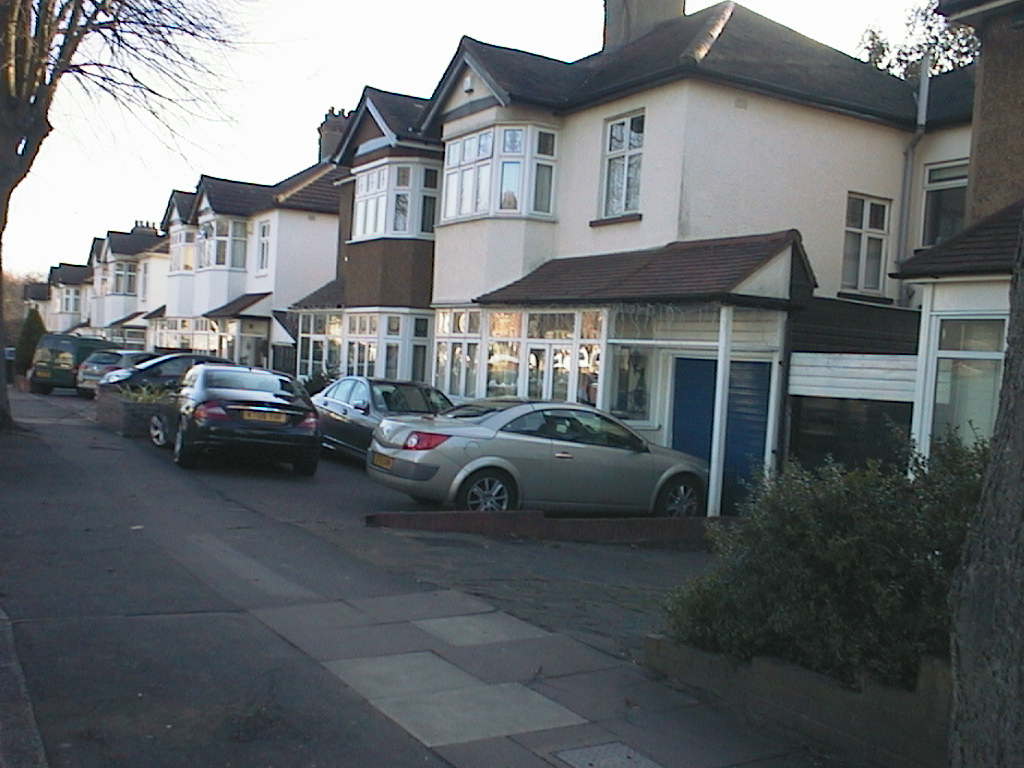
As with the designs by
William Poole and Frank Poole for the Allen and Norris partnership, you
can see
the influence of Bedford Park in these: the double-height bays with a
gable
above the top one; the use of dark brown tiles not slates on the roof
of the
house and the roof of the porch; the dividing of the windows into a
small pane
at the top with a longer one below; the use of casement rather than
sash
windows; the use of white-painted render on the walls.
The bay is tapered rather than square at the
sides - an idea still drawn from Norman Shaw but from Cragside (see
below)
rather than Bedford Park. The bay has a
long straight front; and thereís a rather squat gable above the top of
the bay.
Nearly all the houses
in the row had glassed-in the original porch.
But I think that as originally designed the front door was on
the line
of the front of the ground plan - that is, it wasnít inset; and the
original
porch was open to the elements.
This was not an
elegant design. And whereas Bedford Park
did eliminate the elaborately decorated surfaces of the typical
Victorian
house, you can go too far, and the Nightingale Lane design had no
decoration at
all; unless it was on the original front doors and their surrounds,
which I
couldnít get a good look at.
Harrington had moved from Bedford Parkís
clean lines, to austerity - perhaps befitting the troubled economic
times of
the mid-1920s.
Iím not really keen on
the art historical approach to unattributed designs: attributing them
on
stylistic grounds. However, I couldnít
help noticing some similarities between these houses and the terraced
row on
Bird-in-Hand Lane, below.
The houses below could
have been designed by either William or Llewellyn Harrington. I list them in the order of the dates of
their planning applications:
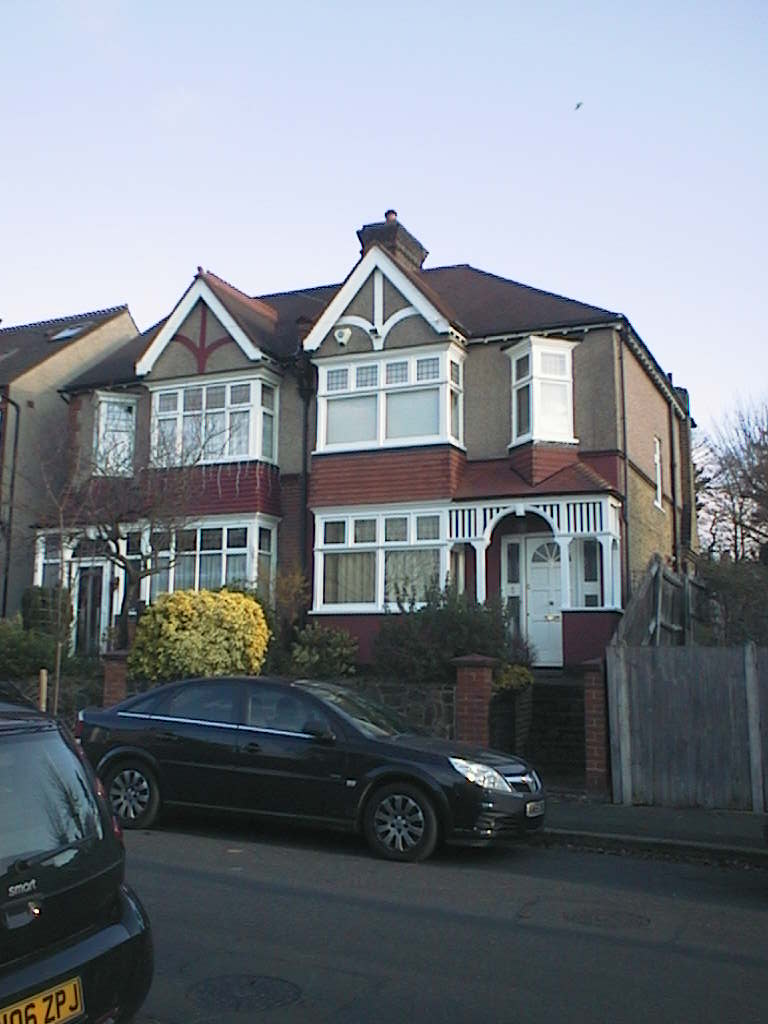
KPEC built one terrace
on the east side of the road; and a short terrace on the west side at
the
northern end; all to the same design.
The other houses in the road were built by another firm. Bedford Park elements that are (I hope)
becoming familiar are in this design: double-height square bays, with
casement
windows divided into a small top and a long bottom pane; a gable above
the bay;
the use of render on the walls (though I donít like the beige colour; I
wonder
if it was original?); brown tiles on the roof; front door on the line
of the
ground plan. There are some interesting
variations on the Bedford Park theme however, and the most obvious is
the Ďtwo
sides of a triangleí oriel window above the front door, lighting the
stairs. Frank Poole had used the same
design on a corner shop on Wimbledon Park Road on the Southfields
estate in
Wandsworth. While the idea of a front
door with one narrow window on each side of it was used at Bedford
Park, the
white-painted railings on the front edge of the porch are another idea
Frank
Poole used at Southfields. The front of
the porch is supported by rectangular posts - you canít call them
columns
really - with a winged design at the top, which I havenít seen at
Bedford Park
though itís probably there somewhere.
The house in the photograph has a nice fan-shaped window in the
front
door but I fear this isnít original.
Further up that row a house not yet modernised had a round
window in its
front door.
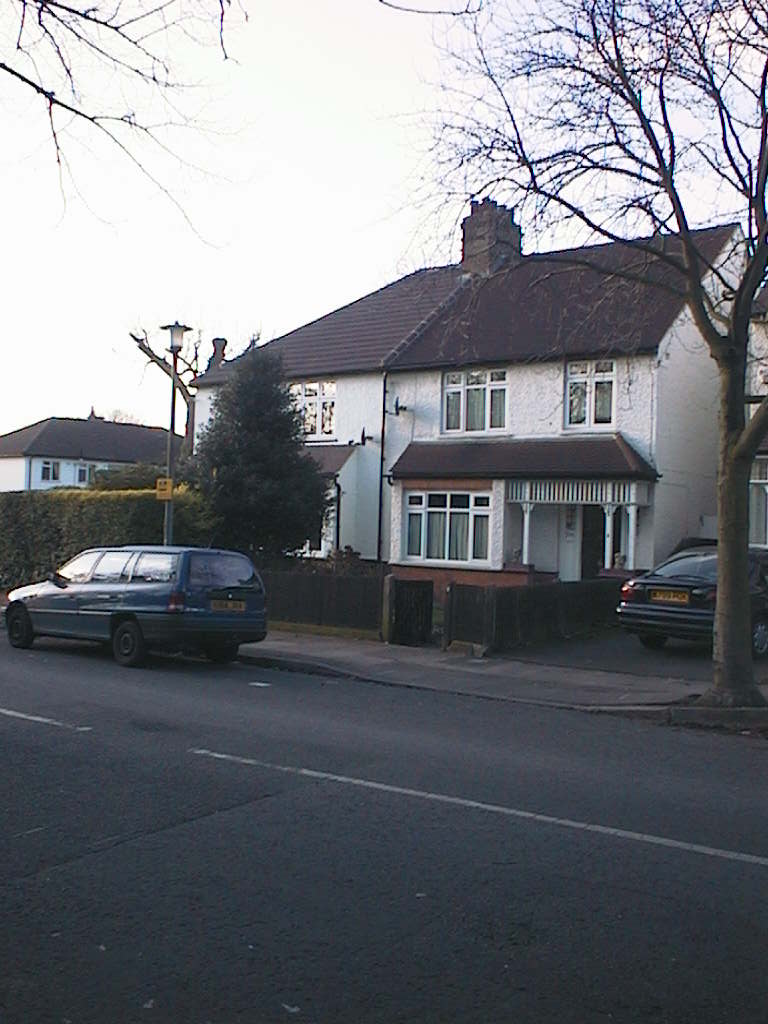
KPEC bought land on
both sides of the southern end of Bird-in-Hand Lane and built houses on
both
sides; though I couldnít identify to my own satisfaction the three big
houses
in their own grounds that were built on the east side of the road. The two houses in the photograph are part of
a terrace, built on the west side northwards to the corner with
Nightingale
Lane though there is one house in the middle thatís not KPEC, I donít
know what
happened there! Itís this terrace that
reminds me of the row in Nightingale Lane:
-
the use of the white-painted
railings on the porch
-
the use of the rectangular
support with the winged top to hold up the porch front
-
the design of the front door, with
a window at the top and a narrow panel down each side, with glass at
the
top.
The terrace was built
in two stages in 1921 and 1922. Again,
the design is very plain and suggests that the brief was to keep costs
down. There is a bay, but itís only one
floor in height. The windows are small
on both floors and have fewer subdivisions than on other KPEC houses. All the walls are rendered.
As with both Nightingale Lane and Amesbury
Road, thereís a tiled roof to the porch; here it goes only to the
nearest edge
of the bay. Below the bay, to the front
door, is red-painted brick; I thought it probably wasnít painted
originally but
some of the other houses in the row also had it including the one that
hadnít
been modernised.
I think William
Harrington designed these.
And now for something
completely different! Iíve explained in
my files on KPEC that I havenít been to Plaistow Bromley to try to
identify
houses built there by the firm. But I have
in my mindís eye a view of what they might look like: 35 Bird-in-Hand
Lane,
built at the same time as 1 and 3 and you can see where all the money
KPEC had
to hand at the time was spent.
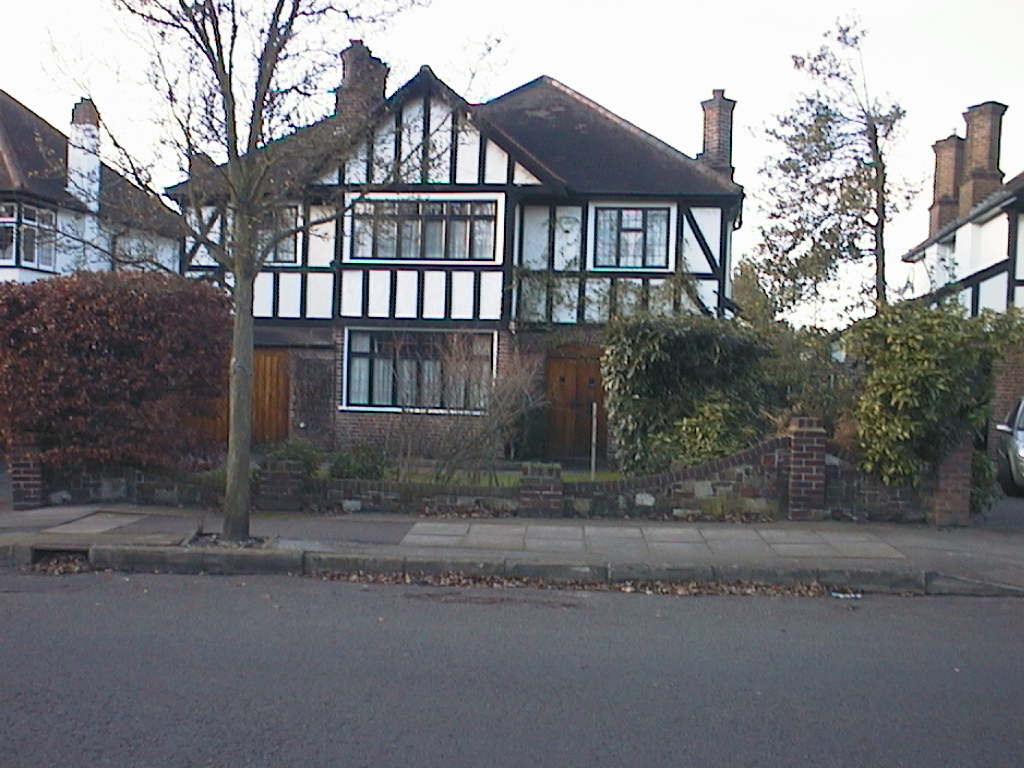
35 Bird-in-Hand Lane is
one of a row of three or four houses built by KPEC on the west side of
the
road, north of its corner with Nightingale Lane. The
planning application is dated 1921 though
they may not have all been built at once.
They are not all identical but they all have similar elements
and
clearly a set based on the same set of ideas.
They are all detached, on a large site and with a generous
ground-plan;
although the front garden, at least, is small for the size of the house.
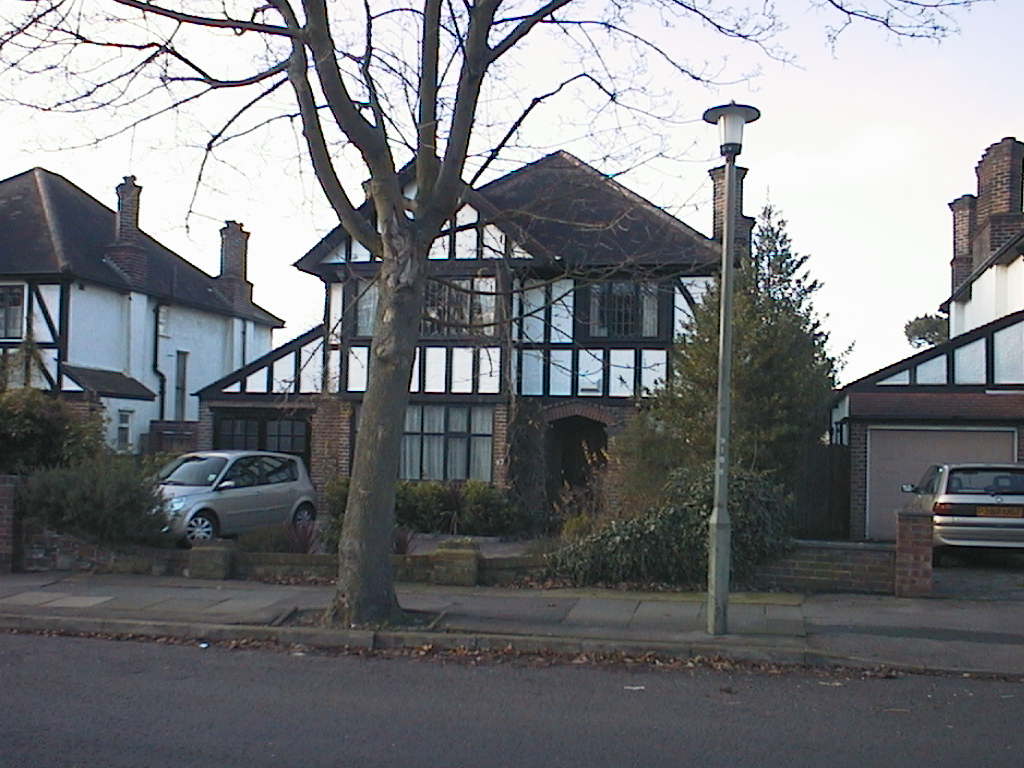
35 Bird-in-Hand Lane
is designed in one block with a garage integral to the building. Number 37 has an extension on the side
incorporating a garage; which may be a recent add-on but is in keeping
with the
original building. 37 also has its front door set into a porch, unlike 35. 35's front door, if original, is an imposing
one with only a very small window in it.
The houses introduce
an element of Richard Norman Shawís architectural designs that you
donít see at
all in any designs built by Allen and Norris: the curse of the
mock-Tudor
executive home - half-timbering. Norman Shawís houses at Bedford Park
donít
have much of it; but he used it lavishly to decorate the tops of the
stone
walls at Cragside House, which he designed for the iron and steel
manufacturer
Lord Armstrong in 1869. Cragside House
is in Northumberland. A house with
half-timbering, by an architect influenced by Norman Shaw and near
enough to
Bickley for the Harringtons to visit it is Munstead Wood House,
designed by the
young Edwin Lutyens for Gertrude Jekyll, the garden designer. Munstead Wood has many Bedford Park elements:
red brick, red tiles, gables, long slopes to the roof; though it
doesnít have
bays, at least not bay windows, and the walls are not rendered. The house is a U-shape and inside the U there
is a first-floor gallery which is half-timbered.
In KPECís group of
houses the half-timbering is a dominating feature of the design: black
wood-beams against white-painted render or red brick.
Another element based on Tudor originals but
also a hallmark of Bedford Park is the two tall, eye-catching chimney
stacks. There is a double-height square
bay (not so Tudor) with a gable over it in typical Bedford Park style.
[ROGER THE NEXT FILE
IN THIS SEQUENCE IS SLHARRI2]
IF YOU WANT TO KNOW
MORE ABOUT THE SOURCES OF ALL THIS INFORMATION, SEND ME AN EMAIL AND
IíLL SEND
YOU THE SOURCES FILE.
Copyright Sally Davis January
2009
***




